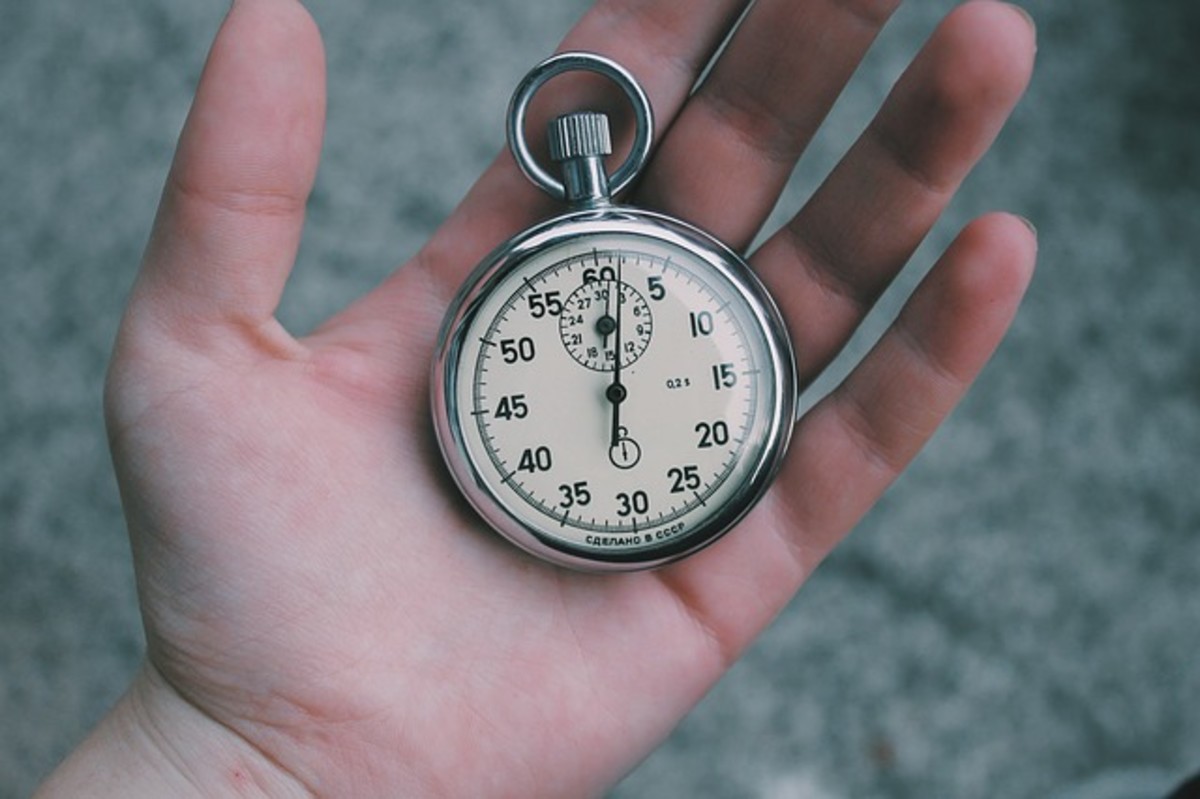Four Steps To Jumpstart Your Morning (According to Science)
The alarm rings. You snooze it. Ten more minutes....
The alarm rings again. You snooze it. Twenty more minutes....
The next thing you know, you only have five minutes to throw on some clothes, brush your teeth, and roll out the door...hopefully with a matching pair of shoes. Last night you got a bit ambitious and set your alarm an hour earlier than normal. You were going to start a new morning routine that would lead to having the perfect day. So much for that. You find yourself thinking "oh well, there's always tomorrow morning."
I can't promise that after reading this article you'll be waking up like a Disney princess, but hopefully these tips and tricks for your morning routine will be as helpful to you as they are to me. Plus they're backed by science!
Good morning sunshine.

1. Kick-Start Your Brain
When you sleep, your brain is working in slow motion. The patterns it's producing when you're snoozing are called theta and delta waves. If you're dreaming about cute puppies, having a flat stomach, or being elected as president, your brain is creating theta waves. These are associated with lighter or REM (rapid eye movement) sleep. Delta waves are produced in a deep, restorative, dreamless state. As you wake up, your brain waves quicken to two new patterns. Alpha waves are first up. They occur when you're having quieter thoughts. Such topics include wondering if you should try Starbuck's new coffee flavor, or if you should stick to your old favorite, The Venti Salted Caramel Mocha Frappuccino Light. Beta waves are at a higher frequency, and happen when you're at the top of your mental game. If you're focused, engaged, and are processing complex ideas, your beta waves are working to make all that learning possible.
Needless to say, the quicker your brain waves move from the delta/theta stage to the alpha/beta stage, the quicker you'll feel awake and alert. Some people will have an easier time with this, as brain chemistry varies. My mind must be running on molasses in the mornings, because waking up is just ridiculously difficult for me. The trick here is to force your brain into a situation where it needs to think critically in order for it to start generating the higher frequency thought patterns.
The first and most important step is to figure out what it is you want to learn. What are you passionate about? Fashion? Math? Cars? A new language? There are a few really great (and really free) teaching apps available to the general public. The most effective will be those that use game-theory. Personally, I'm learning French in the mornings, courtesy of Duolingo. A couple other options include Khan Academy and Luminosity. Next, you need to train yourself to hit the button that will open your chosen app instead of the one that will put five more minutes on your alarm. The key is to begin your lesson as soon as you're awake. This is where that game-theory comes into play (pun intended). These are apps that "reward" you for playing. Generally they use a point system that has no real value. However, your brain interprets those points as mental high-fives. It releases serotonin, the "feel good" neurotransmitter, which encourages you to repeat whatever action you just did. People waste hours on games like Farmville and Candy Crush because your mind decodes the accomplishments you achieve in the game the same way it would if you met a goal in real life. The first few times you open the app in the morning will be a bit difficult, as your brain hasn't been trained to "like" this new activity. Don't worry! The more you do it, the more your receptors will crave the rush of serotonin you get from playing a "game" in the mornings. Not only will you be learning something new, but the increased need for concentration will zip your waves up to beta without you even realizing what's happening! Now you have to decide the amount of time you're going to allow yourself to spend on this part of your morning. Too little and you may still be transitioning from a lower frequency wavelength, too much and you'll spend your whole morning on your phone! I keep my time at about 10-15 minutes per lesson. By then, I'm feeling awake and motivated.
Keep in mind that this technique is possible for those of you who don't have a smartphone or who don't use the alarm on your phone. Keep the time between waking up and starting your lesson as short as possible. To make it most effective, you should find a way to reward yourself at certain points in your daily curriculum.
Soon you'll understand all of this.
![By Tungsten (photo taken by Tungsten) [Public domain], via Wikimedia Commons By Tungsten (photo taken by Tungsten) [Public domain], via Wikimedia Commons](https://usercontent1.hubstatic.com/12657834_f520.jpg)
2. Move That Body
After exercising that big beautiful brain of yours, you don't want your muscles to feel left out. A rush of endorphins are released whenever you work out, leading to increased mood and energy levels. This is where the phrase "runner's high" comes from. When you exercise, your brain is literally releasing the same chemicals as it would on certain drugs. Don't worry, this kind of high is healthy and natural. Even better? This isn't just a temporary feeling. You'll be more likely to choose healthier foods after exercising in the morning, which will allow your energy levels to stay up throughout the day. Another long term effect of getting your blood pumping in the AM is that you give your metabolism a jump start. You'll burn more calories during your daily grind than if you skipped out on working out.
Now to figure out how much time and energy you want to dedicate to this part of your morning. Some people find they like to run for two hours, while others do a five minute fat blast. I'd encourage you to try different things, start slow, and experiment with intensities. If you don't already workout regularly, you'll probably be relying on a guided routine. There are free YouTube workout videos of varying lengths, as well as store-bought DVDs that you can follow until you feel comfortable switching it up. Remember that your muscles are cooler in the morning, so if your routine doesn't already include it, do a warm up before starting any high intensity activity.
I'm fairly strapped for time in the mornings, so I choose to commit about 20 minutes. The first ten are spent on an abdominal circuit, and during the second half I do stretching and yoga. Cardio comes later in the day, when I can commit more time and thought to my routine.
Abs for days.
![By Hu Bing (HB Studio) [CC BY-SA 3.0 (http://creativecommons.org/licenses/by-sa/3.0)], via Wikimedia Commons By Hu Bing (HB Studio) [CC BY-SA 3.0 (http://creativecommons.org/licenses/by-sa/3.0)], via Wikimedia Commons](https://usercontent2.hubstatic.com/12657835_f520.jpg)
3. Fill up and Refuel
Now that you've burned off some calories with your mental and physical exercises, you need to replenish your body's energy. Choose something with good carbs, high fiber, and lean protein to make the most of your breakfast. Studies show that if you eat a healthy morning meal versus one high in fats, you'll reap the rewards throughout the day. Benefits include staying fuller longer, increased alertness, better academic performance, and higher energy levels. Occasionally eating chocolate chip pancakes and bacon is okay, but don't make them a staple in your diet. Everything in moderation!
So what does a carb/fiber/protein diet look like? It doesn't have to be boring or tasteless! Some examples include:
- Greek yogurt flavored with honey or fruit (calcium and protein)
- Oatmeal flavored with honey or fruit (beta-glucan, potassium, and omega 3 fatty acids)
- Fruit smoothie with wheat germ (antioxidants, folate, vitamin E, starch)
- Eggs on toast (healthy cholesterol, fiber, healthy carbs)
Personally, I love fruit smoothies! You can change them up by adding different super fruits, such as blueberries, raspberries, strawberries, and bananas. Create a silky texture by mixing in Greek yogurt or almond milk.
Most of these meals are simple and quick to make, with prep times between 2-10 minutes.
This is not a good breakfast choice.
![By Tracy Hunter from Kabul,, Afghanistan (Chocolate Fudge Cake Uploaded by Ekabhishek) [CC BY 2.0 (http://creativecommons.org/licenses/by/2.0)], via Wikimedia Commons By Tracy Hunter from Kabul,, Afghanistan (Chocolate Fudge Cake Uploaded by Ekabhishek) [CC BY 2.0 (http://creativecommons.org/licenses/by/2.0)], via Wikimedia Commons](https://usercontent2.hubstatic.com/12657837_f520.jpg)
4. Get Some "You" Time
Sometimes we get so caught up in "being productive," that we forget to make some time for ourselves. It's easy to bypass in our daily lives, especially when others count on us for their happiness. However, nurturing your mental and emotional wellbeing is a necessity for a healthy lifestyle. According to science, setting aside some time for yourself is a highly effective coping mechanism to combat stress. It's been linked to
Use at least ten minutes in the mornings for a fun and relaxing activity. Options include reading a book, gardening, meditation, looking up the news, drawing, and writing. You could even do something simple such as sit outside and have a cup of tea or coffee. Really, it's whatever makes you happy!
That being said, it's best to avoid the TV, video games, and social networks during your quiet time. I'm not saying you should completely give them up! However, the most effective personal time is when you engage in activities where you're more likely to be self-reflective, rather than those that make you zone out.
Whatever makes you happy.

Wow, You Look Great!
It hasn't even been an hour and you've already upped your knowledge, worked out, had a healthy breakfast, and reduced your stress. Look at you go!
You've jumpstarted your morning. Now go out there and have an amazing rest of the day.
How happy you'll be after you're new morning routine.
![By Rennett Stowe from USA (That Free Feeling) [CC BY 2.0 (http://creativecommons.org/licenses/by/2.0)], via Wikimedia Commons By Rennett Stowe from USA (That Free Feeling) [CC BY 2.0 (http://creativecommons.org/licenses/by/2.0)], via Wikimedia Commons](https://usercontent1.hubstatic.com/12657842_f520.jpg)
References
Frisvold, D. Nutrition and cognitive achievement: An evaluation of the School Breakfast Program. Journal of Public Economics, 2014; DOI: 10.1016/j.jpubeco.2014.12.003
Infante, J. R., F. Peran, M. Martinesz, A. Roldan, R. Poyatos, C. Ruiz, F. Samaniego and F. Garrido. ACTH and β-endorphin in Transcendental Meditation. Physiological Behavior. 64(3) 311–315, 1998
MacMillan, A. (2013, June 1). Top 20 Foods to Eat for Breakfast. Retrieved from http://abcnews.go.com/Health/Wellness/top-20-foods-eat-breakfast/story?id=19295525#11
Robinson, L., Smith, M., & Segal, R. (2015, August 1). Stress Management: How to Reduce, Prevent, and Cope with Stress. Retrieved from http://www.helpguide.org/articles/stress/stress-management.htm
University of Iowa. "Better breakfast, better grades." ScienceDaily. ScienceDaily, 17 March 2015. www.sciencedaily.com/releases/2015/03/150317112032.htm.
Wolf, T. M. (1994), Stress, coping and health: enhancing well-being during medical school. Medical Education, 28: 8–17. doi: 10.1111/j.1365-2923.1994.tb02679.x








